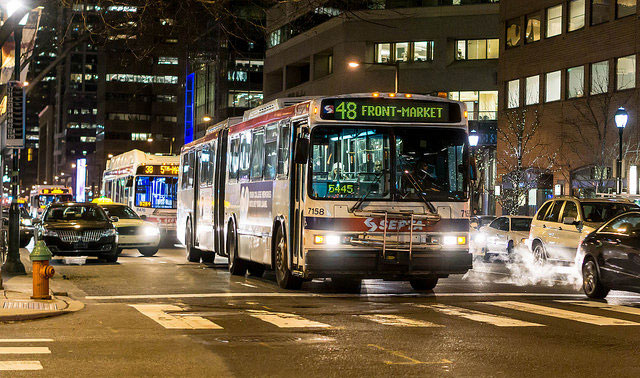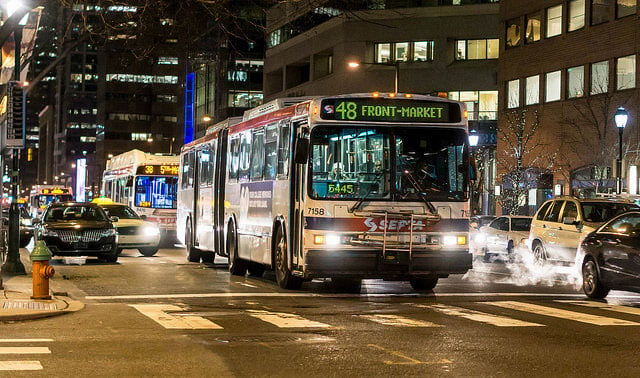
 In the near future, it is likely that cities will come under intense pressure to sacrifice public transportation in favor of new, private, car-dependent alternatives, even at a time when city planners are suggesting reducing or even eliminating car use in cities. (Photo: Jarrett Stewart / Flickr)
In the near future, it is likely that cities will come under intense pressure to sacrifice public transportation in favor of new, private, car-dependent alternatives, even at a time when city planners are suggesting reducing or even eliminating car use in cities. (Photo: Jarrett Stewart / Flickr)
New transportation technologies — self-driving cars, electric vehicles and ride hailing services like Uber — promise to revolutionize transportation, especially in cities. While there are certainly potential benefits to these technologies, they have been called “solution[s] in search of a problem” because many of the benefits touted by advocates of these technologies are benefits that public transportation, walking and cycling already offer in abundance.
One thing rarely mentioned in the enthusiastic boosterism of these technologies is how their widespread adoption will affect the poor. Like other expenditures (especially those on necessities), the poor often pay a large portion of their income on meeting their transportation needs.
The Pew Charitable Trusts recently looked at the burden of transportation costs on the lower third of households and found that it consumed 15.7 percent of their income in 2014. (By contrast, transportation expenses were just 8.2 percent of the income of the top third of households.) This is a significant percentage and it is likely even higher for the poorest households in this group. It is also likely that the vast majority of these expenses were for necessary travel to: work, food shopping or doctors’ appointments. (This group is not taking many vacations.)
Given the impact of transportation costs, cities should look more closely at supporting options, in both the short and long terms, to make cities more equitable and conducive to lower-cost transportation. Paramount among the considerations should be walking, which has very few direct costs, although it is not feasible for those who live far away from where they work, which is the case for many poor people right now. After that, public transportation, which can save many people a significant amount of money per month over using a personal vehicle, and is heavily relied upon by poorer city residents. Cities could do a far better job of serving the transportation needs of low-income people if they made public transportation free and extensive. This is very desirable from an equity perspective and likely only possible on a large scale for public systems. Lastly, cycling is also a low-cost option that cities should accommodate better, even though it suffers from some of the same downsides as walking, at least in most cities as they are currently laid out.
Cities should also be very cautious about supporting new technology that is inaccessible to the poor, such as ride-hailing services, which are usually more expensive than public transportation, are not required to accept cash, and almost always require smartphones and credit cards. For example, The New York Times uncritically touted the UberPOOL carpool service as cheap and environmentally friendly, but most of these benefits were illusory. The trip highlighted in the story was from the Tenderloin to Noe Valley in San Francisco, took somewhere between 25 to 55 minutes, and if split evenly, cost around $10. The same trip on the San Francisco Muni’s J-Church light rail line would have taken 18 minutes and cost only $2.25.
Defending Public Transit
There are undoubtedly some benefits to these new technologies. Self-driving cars could help fill the gaps in public transportation by helping to increase mobility for the elderly, for example, and electric cars create less pollution than gasoline-powered equivalents. But the ongoing and upfront costs for these technologies are significant. Tesla’s “affordable” car, the Model 3, is expected to cost around $42,000 when launched in 2017. Other popular all-electric vehicles, such as the Nissan Leaf and Chevrolet Volt, cost around $30,000 new.
In the near future, it is likely that cities will come under intense pressure to sacrifice public transportation in favor of new, private, car-dependent alternatives, even at a time when city planners are suggesting reducing or even eliminating car use in cities. In fact, a city in Florida has already outsourced some of its services to Uber, which is developing a vehicle that appears to compete with buses. This privatization will have significant consequences.
Washington, D.C.’s Metro rail system might be the next target for privatization. Because of troubling bureaucratic issues and mismanagement by its top-level staff, there have been calls for further privatization, which could result in a system that caters more to an upscale clientele than to workers and the general public. Metro’s paratransit service — MetroAccess — which is already privatized, has imposed significant hardships on its workers, and costs to the D.C. government with fraudulent “billing errors.”
While proponents of these technologies use them to undermine public systems, it’s unclear how these alternatives will be able to serve the number of people that mass transit does, especially if cities are also trying to implement safety plans to decrease the number of vehicle-related fatalities (Vision Zero), and limit the number of cars on the road.
Among the downsides of these technologies — they are expensive and would impose many costs if adopted on a large scale — it’s also important to note that they have not proven their long-term sustainability, either environmentally or economically. Uber, for example, is not a profitable company despite its large share of the taxi market, which it gained in part through aggressive lobbying and illegal practices. Uber also doesn’t own most of the capital involved in its taxi operations (drivers own the cars, albeit sometimes via predatory loans, while passengers own their phones), which might lead to questions about why Uber as a company needs to exist at all, especially when there are more fair models that make more sense. Reconsidering a city’s need for Uber, rather than giving away markets to it, would be much better for Uber employees, whom it exploits by misclassifying them as independent contractors and by changing its payment structure. Politically, it would take a lot of effort for a city to force Uber to stop operating. This is due in part to the rapid gentrification of many cities in the US: the relatively rich people that are moving in prefer using taxis or private vehicles, and city institutions and politicians are very responsive to those people’s needs, to the detriment of others. However, Austin, Texas, was able to force Uber and its competitor Lyft to stop operating in May, after both companies refused to comply with safety regulations.
In the coming years, it will be important to remind politicians and residents that unless new technology is equitable, regulated and aligned with future goals, it shouldn’t be a significant part of a city’s transportation system. In addition, it is difficult to understate the importance of public transportation to the poor, or to the economy generally. Increased investment in public transportation — and a smart strategy to grow cities around public transportation and not cars — should probably be a focus of any city’s development for these reasons.
Join us in defending the truth before it’s too late
The future of independent journalism is uncertain, and the consequences of losing it are too grave to ignore. To ensure Truthout remains safe, strong, and free, we need to raise $27,000 in the next 24 hours. Every dollar raised goes directly toward the costs of producing news you can trust.
Please give what you can — because by supporting us with a tax-deductible donation, you’re not just preserving a source of news, you’re helping to safeguard what’s left of our democracy.